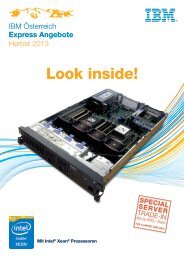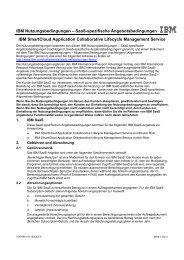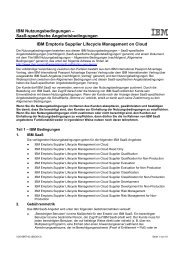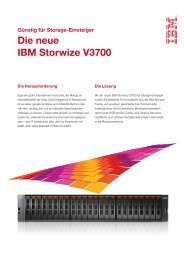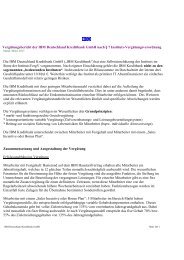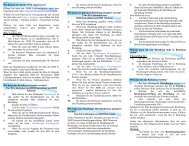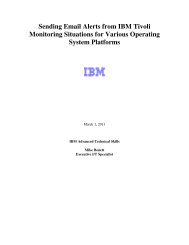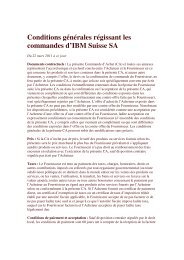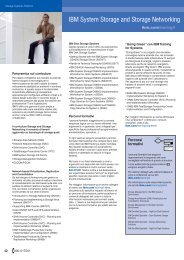ToF-SIMS analysis of glass fiber cloths for PCB manufacturing - IBM
ToF-SIMS analysis of glass fiber cloths for PCB manufacturing - IBM
ToF-SIMS analysis of glass fiber cloths for PCB manufacturing - IBM
Create successful ePaper yourself
Turn your PDF publications into a flip-book with our unique Google optimized e-Paper software.
<strong>ToF</strong>-<strong>SIMS</strong> <strong>analysis</strong> <strong>of</strong> <strong>glass</strong> <strong>fiber</strong> <strong>cloths</strong><br />
<strong>for</strong> <strong>PCB</strong> <strong>manufacturing</strong><br />
<strong>PCB</strong> Symposium Raleigh 2011<br />
Dylan Boday 1 , Michael Haag 2 , Joe Kuczynski 3 , Markus Schmidt 2 , Michael Wahl 4 , Johannes Windeln 2<br />
1 <strong>IBM</strong> Systems & Technology Group, 9000 S Rita Rd, Tucson AZ 85744-0002, dboday@us.ibm.com<br />
2 <strong>IBM</strong> Deutschland MBS GmbH, Hechtsheimer Str. 2, D-55131 Mainz, mhaag@de.ibm.com<br />
3 <strong>IBM</strong> Systems & Technology Group, 3605 Hwy 52 N, Rochester MN 55901-1407, kuczynsk@us.ibm.com<br />
4 IFOS GmbH, Trippstadter Straße 120, D-67663 Kaiserslautern, wahl@ifos.uni-kl.de
content<br />
• <strong>PCB</strong> (Printed Circuit Board) structure<br />
• <strong>glass</strong> cloth conditioning<br />
• motivation <strong>for</strong> <strong>ToF</strong>-<strong>SIMS</strong> <strong>analysis</strong><br />
• analytical setup<br />
• <strong>ToF</strong>-<strong>SIMS</strong> results<br />
• summary and outlook<br />
<strong>PCB</strong> Symposium Raleigh 2011<br />
11/11/11 2
<strong>PCB</strong> structure<br />
prepregs<br />
cores<br />
copper lines<br />
prepregs: <strong>glass</strong> <strong>fiber</strong> cloth pre-impregnated with resin matrix<br />
<strong>PCB</strong> Symposium Raleigh 2011<br />
heat, pressure<br />
heat, pressure<br />
pictures source: www.lpkf.de<br />
cores: cured <strong>glass</strong> cloth/resin composite with structured copper layer(s)<br />
multi-functionality <strong>of</strong> composite (<strong>glass</strong> cloth, resin and optional filler)<br />
- mechanical properties (strength, CTE...)<br />
- dielectric properties (insulation, impedance...)<br />
11/11/11 3
<strong>glass</strong> cloth conditioning<br />
<strong>PCB</strong> Symposium Raleigh 2011<br />
<strong>glass</strong> <strong>fiber</strong>s pre-treated with Silanes <strong>for</strong><br />
- improved surface wetting (contact angle reduction)<br />
- improved matrix adhesion (organ<strong>of</strong>unctional group R to match matrix resin)<br />
11/11/11 4
process steps critical with regard to Silanation:<br />
- starch size required <strong>for</strong> yarn processing<br />
- pyrolytic de-sizing (thorough?)<br />
- Silanation process<br />
application <strong>of</strong> starch sizing<br />
<strong>glass</strong> cloth conditioning<br />
pyrolytic de-sizing<br />
source: JPS Composite Materials<br />
<strong>PCB</strong> Symposium Raleigh 2011<br />
(wet) application <strong>of</strong> Silanes<br />
11/11/11 5
<strong>PCB</strong> Symposium Raleigh 2011<br />
motivation <strong>for</strong> <strong>ToF</strong>-<strong>SIMS</strong> <strong>analysis</strong><br />
challenges <strong>for</strong> modern high per<strong>for</strong>mance boards<br />
- increasing # <strong>of</strong> copper layers (�40 and above)<br />
- decreasing line width and spacing (� 50µm and below)<br />
- RoHS (Pb-free solder; solder process + 20K, new resins)<br />
���� known sporadic failures become epidemic!<br />
Thermal cracks:<br />
pictures source: Dynamic Details Inc.<br />
SEM micrograph: <strong>IBM</strong><br />
CAF: Copper Anodic Filament<br />
11/11/11 6
<strong>PCB</strong> Symposium Raleigh 2011<br />
motivation <strong>for</strong> <strong>ToF</strong>-<strong>SIMS</strong> <strong>analysis</strong><br />
TGA and SEM/EDX results <strong>of</strong> analysed <strong>glass</strong> cloth<br />
indicate presence <strong>of</strong> undesired material<br />
expected weight loss < 0.1%!<br />
TGA <strong>analysis</strong> and SEM micrographs: <strong>IBM</strong><br />
organic debris<br />
11/11/11 7
<strong>ToF</strong>-<strong>SIMS</strong><br />
Time-<strong>of</strong>-Flight Secondary Ion Mass Spectrometry<br />
(Sample)<br />
<strong>PCB</strong> Symposium Raleigh 2011<br />
extractor accelerates secondary ions to:<br />
E = q ⋅ U<br />
mass dispersion via ion flight time:<br />
v =<br />
⇒<br />
t<br />
=<br />
2E<br />
m<br />
s<br />
v<br />
=<br />
= s ⋅<br />
2q<br />
⋅ U<br />
m<br />
m<br />
2q<br />
⋅ U<br />
11/11/11 8
analytical setup<br />
Method: <strong>ToF</strong>-<strong>SIMS</strong> static and dynamic mode<br />
Tool: ION-TOF IV at , Germany<br />
<strong>PCB</strong> Symposium Raleigh 2011<br />
Primary ions: 25keV Bi 3 + (clusters to promote molecular secondary ions)<br />
Samples: various samples <strong>of</strong> <strong>glass</strong> cloth –<br />
supposedly de-sized and coated with coupling agent<br />
sample<br />
#<br />
1<br />
2<br />
3<br />
4<br />
5<br />
6<br />
supplier<br />
A<br />
B<br />
C<br />
C<br />
C<br />
C<br />
cloth<br />
2116<br />
1080<br />
1080<br />
2113<br />
0106<br />
2116<br />
11/11/11 9
<strong>ToF</strong>-<strong>SIMS</strong> - static mode<br />
raw spectra<br />
significant differences especially in the hi-mass region<br />
<strong>PCB</strong> Symposium Raleigh 2011<br />
#6 #6<br />
#6<br />
11/11/11 10
<strong>ToF</strong>-<strong>SIMS</strong> - dynamic mode<br />
dynamic mode to distinguish between signals from<br />
surface coverage and bulk material<br />
<strong>glass</strong> bulk<br />
surface coverage<br />
sputter<br />
removal<br />
sputter<br />
removal<br />
<strong>PCB</strong> Symposium Raleigh 2011<br />
11/11/11 11
<strong>ToF</strong>-<strong>SIMS</strong> – first results<br />
� <strong>ToF</strong>-<strong>SIMS</strong> imaging capability<br />
(microscopic picture 300µmx300µm „in the light <strong>of</strong> an ion mass“)<br />
<strong>PCB</strong> Symposium Raleigh 2011<br />
� major signals assigned to one <strong>of</strong> 4 peak groups with common<br />
appearance and behaviour<br />
group A: group B: group C: group D:<br />
11/11/11 12
<strong>ToF</strong>-<strong>SIMS</strong> – peak groups<br />
group A (<strong>glass</strong> constituents)<br />
� laterally homogeneous signal<br />
� <strong>glass</strong> constituents (Li, B, Mg, Al, Si, Ca, Ti, Na, K)<br />
<strong>PCB</strong> Symposium Raleigh 2011<br />
� signal increased after sputter removal <strong>of</strong> surface layer (≈30nm)<br />
� confirms <strong>glass</strong> constituent<br />
different:<br />
� Na and K: signal increase after sputter on #7,<br />
signal decrease on #1 � sizing component?<br />
after sputter removal<br />
<strong>of</strong> surface layer:<br />
11/11/11 13
<strong>ToF</strong>-<strong>SIMS</strong> – peak groups<br />
group B (inhomogeneity I)<br />
� signal limited to prominent portions <strong>of</strong> single <strong>fiber</strong>s<br />
� Sulfate component<br />
<strong>PCB</strong> Symposium Raleigh 2011<br />
� signal decreased after sputter removal <strong>of</strong> surface layer (≈30nm)<br />
� confirms surface coverage<br />
residues from sizing or just abrasion debris from plastic bag?<br />
after sputter removal<br />
<strong>of</strong> surface layer:<br />
11/11/11 14
<strong>ToF</strong>-<strong>SIMS</strong> – peak groups<br />
group C (homogeneous organics)<br />
� laterally homogeneous signal<br />
� mainly hydrocarbons (C 7 H 7 , C 9 H 7 , C 9 H 9 , C 10 H 8 )<br />
� phosphate component<br />
<strong>PCB</strong> Symposium Raleigh 2011<br />
� signal decreased after sputter removal <strong>of</strong> surface layer (≈30nm)<br />
� surface coverage<br />
coupling agent?<br />
after sputter removal<br />
<strong>of</strong> surface layer:<br />
11/11/11 15
<strong>ToF</strong>-<strong>SIMS</strong> – peak groups<br />
group D (inhomogeneity II)<br />
� signal confined to small areas on single <strong>fiber</strong>s<br />
� fragmentation pattern match: Erucamide (m=337)<br />
<strong>PCB</strong> Symposium Raleigh 2011<br />
� signal decreased after sputter removal <strong>of</strong> surface layer (≈30nm)<br />
� surface coverage<br />
coupling agent or residues from sizing?<br />
after sputter removal<br />
<strong>of</strong> surface layer:<br />
11/11/11 16
<strong>ToF</strong>-<strong>SIMS</strong> – second run<br />
Method: <strong>ToF</strong>-<strong>SIMS</strong> static and dynamic mode<br />
Tool: ION-TOF IV at , Germany<br />
<strong>PCB</strong> Symposium Raleigh 2011<br />
Primary ions: 25keV Bi 3 + (clusters to promote molecular secondary ions)<br />
Samples: 1. 2116 <strong>glass</strong> cloth w/ Silane treatment (supplier‘s claim)<br />
- as received<br />
- heat cleaned (matching pyrolytic de-sizing)<br />
- UV-ozone cleaned (details undisclosed)<br />
2. pellet <strong>of</strong> <strong>glass</strong> raw material (as used to pull <strong>fiber</strong>s <strong>for</strong> 2116)<br />
analyzed as a reference<br />
- as receiced<br />
- on freshly fractured surface<br />
- on sputter cleaned surface<br />
11/11/11 17
Glass cloth<br />
analyses<br />
first results<br />
<strong>PCB</strong> Symposium Raleigh 2011<br />
NO SiCH 3 O + as reported by Norrmann et al (J. Mass Spectrom. 2002, 37, 695-708)<br />
NO other SiC complexes<br />
signal<br />
1,0E+05<br />
1,0E+04<br />
1,0E+03<br />
1,0E+02<br />
1,0E+01<br />
CH_3+<br />
potentially Silane related: C x H y + and Cx H y O +<br />
but no change after heat and UV ozone treatment!<br />
C_2H_3+<br />
C_2H_5+<br />
C_3H_5+<br />
C_3H_7+<br />
C_4H_7+<br />
C_4H_9+<br />
C_5H_7+<br />
C_5H_9+<br />
element / fragment<br />
heat treated<br />
UV ozone<br />
as received<br />
C_2H_3O+<br />
C_3H_3O+<br />
C_3H_5O+<br />
11/11/11 18
Glass pellet<br />
analyses<br />
first results<br />
signal<br />
1,0E+06<br />
1,0E+04<br />
1,0E+02<br />
1,0E+00<br />
<strong>PCB</strong> Symposium Raleigh 2011<br />
potentially Silane related species C x H y + and Cx H y O +<br />
also present on bulk reference sample!<br />
����adsorbates from the ambient<br />
C_2H_3+<br />
C_2H_5+<br />
C_3H_5+<br />
C_3H_7+<br />
C_4H_7+<br />
C_4H_9+<br />
C_5H_7+<br />
C_5H_9+<br />
element/fragment<br />
fracture surface<br />
sputter cleaned<br />
as received<br />
C_2H_3O+<br />
C_3H_3O+<br />
C_3H_5O+<br />
11/11/11 19
summary and outlook<br />
new <strong>ToF</strong>-<strong>SIMS</strong> application in reverse engineering:<br />
Silane treatment <strong>of</strong> <strong>glass</strong> fibre cloth<br />
first results on supplier samples:<br />
NO Silane related secondary ions detected<br />
� functionalized surface not as desired<br />
- Silanes either not present<br />
next steps:<br />
<strong>PCB</strong> Symposium Raleigh 2011<br />
- or only physisorbed instead <strong>of</strong> chemisorbed<br />
(due to insufficient fibre treatment)<br />
�work with supplier to improve Silanation process<br />
�Is “pad cratering” part <strong>of</strong> the same problem?<br />
�Is this the time to involve „computational materials science“?<br />
11/11/11 20



